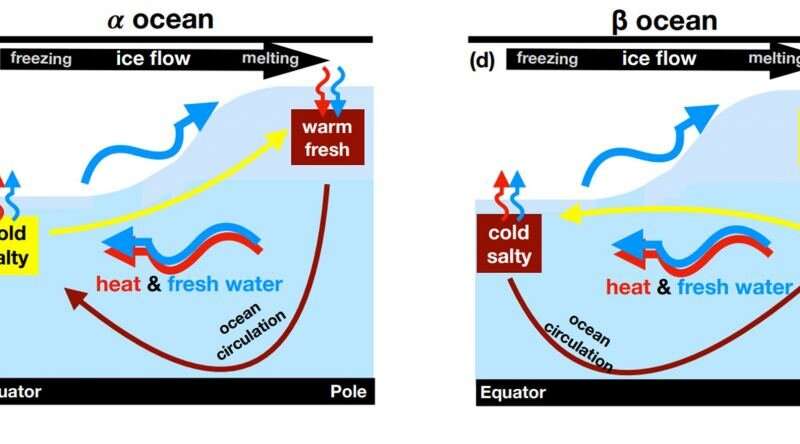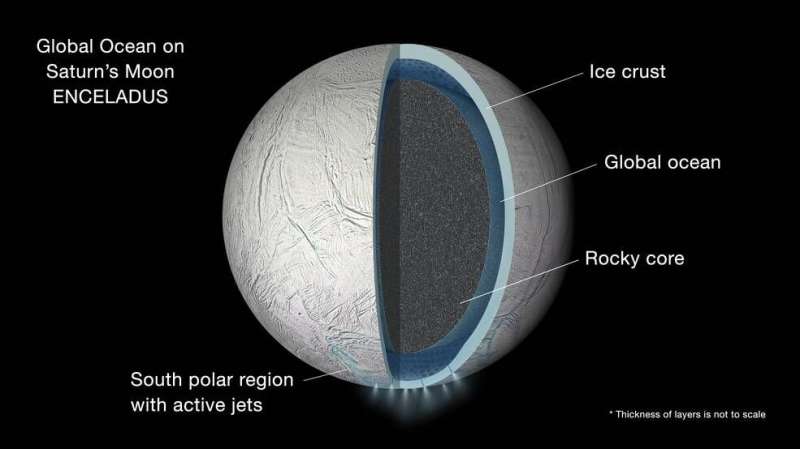If life does exist, ocean circulation, which is also indirectly dependent on salinity, will determine where the heat, nutrient and potential biosignatures are transported to, and therefore is the key to the detection of biosignatures.
A team of scientists working with Dr. Wanying Kang at MIT approaches these questions by numerically simulating the likely ocean circulations for various possible levels of salinity and evaluating the likelihood of each scenario by asking whether it is able to maintain the observed ice shell geometry that Cassini mapped out on the icy moon.
Ocean circulation is dependent on differences in density of its constituent water in different parts of the ocean. Water that is more dense will flow toward water that is less dense in order to reach a equilibrium. Those density differences are themselves controlled by two key factors, the location of the moon's heat source and the ocean salinity, both of which are currently poorly understood.
There are two places on Enceladus for a potential heat source: in the silicate core or in the lower ice shelf where it meets the upper part of the ocean. If a significant amount of heat is produced in the silicate core through tidal flexing underneath the ocean, scientists would expect to see convection, just like what happens when you boil a pot of water. Similarly, if freezing happens atop of the ocean, salt will be expelled out of the ice, increasing the local water density and triggering convection from the top.
Salinity also plays a key role in those density calculations. For relatively low salinity levels, water contracts upon warming near the freezing point, making it more dense. Since Enceladus' ocean is in contact with a global ice shell, it is near freezing. This is counterintuitive to how most people think of warming—which generally implies that material becomes less dense with increasing temperature. At higher salinities, this becomes true and water starts to behave normally, expanding upon warming.
Given the uncertainty of Enceladus' ocean salinity (between 4-40 grams of salt per kilogram of water) and what percentage of the planet's heating takes place at either of the two sources, Dr. Kang and her coauthors utilized MIT's ocean model to simulate the ocean circulation under various combinations, assuming that the observed ice shell is maintained by freezing in the thick ice regions and melting elsewhere. This largely holds true for icy worlds, as ice shelves would flatten out naturally over time due to ice flow if no other process is maintaining a difference.

Image from the paper showing the cycle of water and ice in Enceladus’ oceans. Credit: Kang et all 
Artist rendering showing an interior cross-section of the crust of Enceladus, which shows how hydrothermal activity may be causing the plumes of water at the moon’s surface. Credit: NASA-GSFC/SVS, NASA/JPL-Caltech/Southwest Research Institute
The team diagnosed the heat transport under various scenarios and found only a few of them can broadly maintain a "balanced" heat budget, i.e., how the various sources of heat (the amount of heat flux from the ocean to the ice, plus the heat production in the ice due to tidal flexing, plus the latent heat release) can exactly balance the conductive heat loss through the ice shell.
According to the model, such a balance can be achieved broadly if the ocean salinity is at some intermediate level (10-30 g/kg) and if the ice shell is the dominant heat source. When these two conditions are satisfied, the ocean circulation is weak. As a result, the warm polar water won't be mixed toward the equator too efficiently, so equatorial melting won't happen. This results in an ice shelf which is thicker around the equator of the moon, as was observed by Cassini. It also implies that the pressure at the water-ice interface is lower at the poles, meaning it also has a higher freezing point than water at the equator.
For those scenarios with an "unbalanced" heat budget, meaning some of the heat created on the moon isn't conducted away, the equatorward heat transport is too efficient and the equatorial ice shell will tend to melt. Meanwhile, the pressure gradient force will drive an ice flow from the equator to the poles. Together, the melting and ice flow will reduce the ice thickness near the equator, inevitably. Under this scenario, the observed ice geometry can't be maintained over the moon's lifetime.
Explore further



